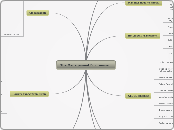BIO311D
Pollution
Acid Rain
HNO3
Nitric Acid
H2SO4
Sulfuric Acicd
Nuclear Radiation
Nuclear Winter
Causes:
-Temperature decrease
-Darker
-photosynthesis decrease
-productivity decrease (worldwide)
Global Warming
In coming years:
Temperature INCREASE
Causing:
Biological Changes:
-Lattitudinal/poleward shift in species ranges
-earlier spring events/later fall events
-coral bleaching
-species extinctions
Most Negatively Effected:
-cold adapted organisms
-severely range restricted species
ex) Maple tree ranges moving North
Beech tree ranges moving north
Euphydaas editha (butterfly) moving north
along west coast
Physical Environment Changes:
-warmer ocean temperatures (releases methane gas)
-Higher sea levels (due to glacier melting)
-more intense hurricanes
-change in percipitation
Green-house Gasses
retardation of heat escaping the atmosphere by certain "greenhouse gases"
CFCs
Ozone Depletion
(Concentration thinning)
greatest depletion of ozone over SOUTH POLE (ANTARTICA)
allows UV light to more easily penetrate Earth's surface
have seen in increase in skin cancer
Nitrous Oxide
Methane Gas Increase
(in atmosphere)
CO2 Levels Increasing
(in atmosphere)
Positive correlation to
temperature RISE
CO2 "Sinks"
-photosynthetic plants
-oceans
Human Evolution
Shared common ancestor with
Apes ~6.5 mya
Later developed into
present day apes
Ardipithecus
(Bipedal)
over 5 mya
Bipedalism was more beneficial seeing as the African Rift Valley was changing from a tropical to a savannah landscape. Standing upright allowed our ancestors to see above the tall grasses, reach food on trees, cool more efficiently from the sun, and most notably: conserve more energy (as this was more energy efficient than walking long distances on four legs).
Australopithecus
over 4mya
Extinctions caused by ENVIRONMENTAL CHANGES.
A. ganhi
Homo erectus
1.8mya-350,000
moved out of Africa to
Middle East, Asia...
Adaptations such as
endurance running, sweating,
and less body hair were seen here.
lead to "Persistence Hunting"
(needed bigger meaty foods
to support larger bodies and
brains).
(Archaic) Homo sapiens
evolved 350,000
years ago
H. sapiens sapiens
(move from Africa and
Middle East)
H. sapiens sapiens have ~3% neandertal DNA in us.
Outlived neandertals due to taller slimmer bodies which require less energy to sustain, more advanced hunting tools (such as throwing spears) allowed them to get food without putting themselves in harm's way.
No major extinctions in Africa
(people were already residing there
from the beginning, thus there was
no major change)
Traveled to Asia and Australia
60,000 years ago
Reached South Pacific
Islands moving from SE Asia
islands that are much closer geographically have residents that are closer related genetically as well, when compared to islands that are further apart
Traveled to
New World
25,000 years ago
North America:
extinction of many animals 14,000-6,000
years ago bc hunted to extinction
Presence of humans increases the probability of extinction for animals in the area. Major BIODIVERSITY effect!
Why so little genetic variation today?
Theorized bottleneck effect. All mankind
today derived from ~600 breeding individuals
Later reached
South Americas
H. sapiens neandertals
(goes to Europe and Middle East)
FoxP2 gene found in neandertal DNA led scientists to believe neandertals could has possibly had a language.
DIES OUT
Possible causes of extinction:
-Not advanced enough technology to catch food in order to sustain and maintain food requirements for large bodies.
-Lived in cold climates
-H. sapiens sapiens were better adapted to enviornment, started out competeing neandertals, leading to their demise.
Homo habilis
2-1.8mya
First signs of greater encephalization:
(more intelligent beings
had more offspring- thus, larger brains
continued to be passed down)
A. Afarensis (Lucy)
common ancestor
Adaptive Radiation
Is a result of natural selection
Adaptive Differentiation
development of different PHENOTYPES from a common ancestor due to adaptations to different environments
Character
Displacement
selection working in opposite directions. There is compeition at the mean so phenotypes diverge in order to reduce competition.
ex) Galapagos Finches Beak Size: separately they are similar, over time beak size diverged to reduce competition in eating the same food.
**also: Competitive Exclusion
Form of
Divergent Evolution?
Mutations and
Genetic Drift
Genetic Drift:
random changes in gene frequency from
one generation to another due to
SAMPLING ERROR
sampling error= chance variation from the expected value. With a larger population size, there is less of a chance of sampling error.
Issues with sampling error:
Founder Effect
(*Within the same generation)
New "colonizing" population's gene frequencies not likely to be the same as original population due to sampling error.
Bottleneck Effect
After a catastrophe where populations are greatly reduced in size, more prone to extinction bc LOSS OF HETEROZYGOSITY. Could lose an allele which would reduce the amount of genetic variation.
Hardy Weinberg Equilibrium:
p^2 + 2pq + q^2 = 1
(When GENOTYPIC frequency
stays the same from generation
to generation)
p & q are allelelic frequencies
Fixed: allele goes to 1
Lost: allele goes to 0
Most populations either fix or lose an allele by CHANCE, this results in a genetic drift over time.
For evolution to occur
there must be:
-Nonrandom mating
-Small population size
-Mutations must occur
-Migration
-Sexual selection
sexual selection is ALWAYS phenotypic
For HWE to exist, must be:
-Need random mating
-No mutations
-Large population size
-No migration
-No selection
Mutation:
Random changes in genetic code,
Thus ULTIMATE source of
genetic variation
Evolution arises from advantageous mutations
being selected for (individuals with that mutation
reproduce more offspring, continuing trait)
Meiosis
Mistakes
Polyploidy
Meiotic Nondisjunction
(in Anaphase I or II?)
produces deficient (ex. monosomic)
or duplicate (ex. trisomic) gametes
Produces gametes
Meiosis II:
Prophase II
Metaphase II
Anaphase II
Telophase II
Chromatid Disjunciton during
Anaphase II
Meiosis I:
Prophase I
Metaphase I
Anaphase I
Telophase I
Chromosome disjunction during
Anaphase I
Life Cycles
G1 - S (DNA Replication) - G2 - Mitosis - Meiosis









